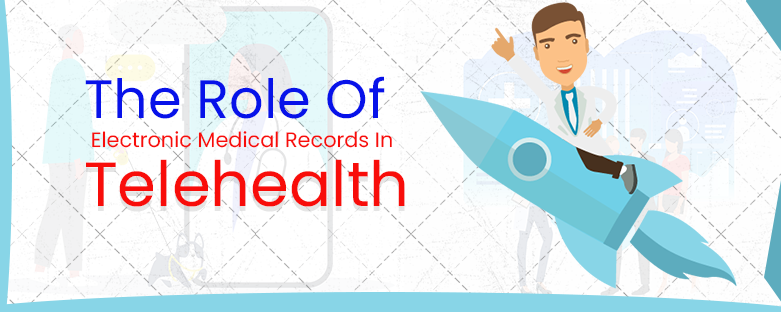The Role of Electronic Medical Records in Telehealth
Telehealth has recently taken off as a method of avoiding the transmission of the novel coronavirus, but even though telehealth has been around for many years, pre-COVID-19 has been difficult for clinics to embrace it. This led telehealth to not be viewed by hospitals as a realistic alternative, and it was instead seen as a last resort healthcare solution. By supplying patients with fast and reliable healthcare options, electronic medical records (EMR) can assist Telehealth. An EMR System plays an essential part in telemedicine. In this article, we’ll know the role of Electronic Medical records (EMR) in Telehealth and Telemedicine.
What Is Electronic Medical Records Integration?
Many hospitals have one or more outlets that they use as digital patient records for the Electronic Medical Record (EMR). These tools allow them to collaborate with a healthcare team and organize patient care. It is built into their workflows which require Computerized Physician Order Entry (CPOE) for ordering hospitals, medications, treatments, radiology, all. EMR Incorporation ensures that with the EMR networks at the hospital, the machine can chat and share information.
Much when they buy anything else, clients like to be able to order a telemedicine appointment. We’re yet another option on a CPOE menu with incorporation, so it’s smooth for their workflow.
Electronic Medical Records Integration and Telehealth:
EMR: Electronic medical records are just automated copies of the paper charts that doctors use to keep track of the medical and therapy histories of their patients.
EMRs encourage doctors to have access to knowledge about all their patients in one location. For each patient, this is a perfect solution to keeping hold of dense paper archives.
By supplying patients with fast and safe healthcare options, electronic medical records will enable telemedicine.
The debate about the interoperability of EMRs has spiked as the market has moved gradually towards telehealth. For the increased quality of treatment, lower opioid interaction rates, reduced death rates, better provider coordination, and most health services today have EMR in place and focus on the automated equivalent of the paper-based medical record.
Read Also: Benefits and Challenges of Electronic Health Record (EHR)
How Will a Combination of EMR Improve Telemedicine?
90% of healthcare leaders have confirmed that a telemedicine service has either been developed or adopted by their organizations. For any healthcare provider, integrating this with a comprehensive EMR scheme will prove to be a brilliant upgrade. This approach will allow doctors and medical institutions to practice secure medical treatments where they can pull the medical records of a patient in only one click-leaving no space for miscommunications to be misunderstood. It would exponentially help these organizations remain structured in terms of keeping the records of their patients very securely.
Telemedicine and EMR will help clinicians log into their secure accounts easily and change the history of the patient, while the e-prescribing solution will help patients save time waiting for a signed prescription.
Effects on Telehealth of Electronic Medical Records:
EMR integration with the telehealth solution of an entity enables full and efficient treatment to be provided, while simultaneously streamlining workflows for clinicians and minimizing redundancy. Effective adoption would result in more convenient patient services, greater patient quality, and increased health system-wide infrastructure experience for providers.
Benefits of Electronic Medical Records:
There are a variety of advantages, including the following that comes with making the switch to EMR:
1. Space Savings:-
Many people are willing to conserve space where rows and shelves of paper maps will usually be kept.
2. More Secure:-
For a private practice, missing even one page of a patient’s file can be devastating. EMR helps you to keep sensitive information from being lost. Data backup also means that, in the case of a fire or other incident, your files are safe.
With EMR incorporation, the possibility of fraud often goes way down since only registered users have access to the details of a patient.
3. Identifying Interactions and Allergies More Easily:-
Accidents can arise, and medicine that is either contraindicated because of an infection or because they are on another medication that should not be administered with the new option can often be given to patients. These conditions may be identified by qualified EHR software before they become a concern or a health emergency.
Read Also: Why Telemedicine is Important for the healthcare Industry?
4. Widespread Access:-
When a patient’s doctor wants a chart, where do they have to go to get it? Is it close or all the way to the other end of the hospital? If these records are accessible in the hospital on any device that saves doctors time trekking from one floor to another. Those are precious minutes that should have been spent saving lives.
Although distances in small hospitals and private practitioners are shorter, no less important is the time spent locating documents. For health organizations of all types, EMR programs are useful.
5. Safer
Throughout the day, physicians see too many people that it’s not unusual to forget the allergies of a patient or the other medications they are taking.
When a doctor forgets that a patient is allergic to a certain medication or may not know that their prescription may lead poorly to one that they are taking, the final effects could be tragic.
This is one of the main advantages of electronic medical records. As soon as a prescription is written, they improve patient protection by immediately implementing drug-to-drug and drug-to-allergy contact tests.
Have an Idea about EMR Application?
Connect with us to build your own software and Get the FREE estimation of your product idea.
Talk to us




EMR is the best feature of telehealth, in my opinion, because you no need to carry physical documents, and you can access your healthcare records anywhere and anytime.
Thank you for sharing; this is a great and informative post.
Page UI is fantastic, and the information provided on EMR is excellent.
thanks, this is a super useful step-by-step guide. Thank you so much.
Hey, such a great post. I liked the way of explanation. thanks for sharing.
I do not even understand how I finished up right here. However, I assumed this post was good.
I do not know who you’re however certainly you’re going to be a well-known blogger in case you are not already.
Cheers!
Your article gave me a lot of inspiration, I hope you can explain your point of view in more detail, because I have some doubts, thank you. 20bet